Trump Judges Will Hit Their Peak in 2040
A quirk in our system combined with shrewd gamesmanship will give them unprecedented power.
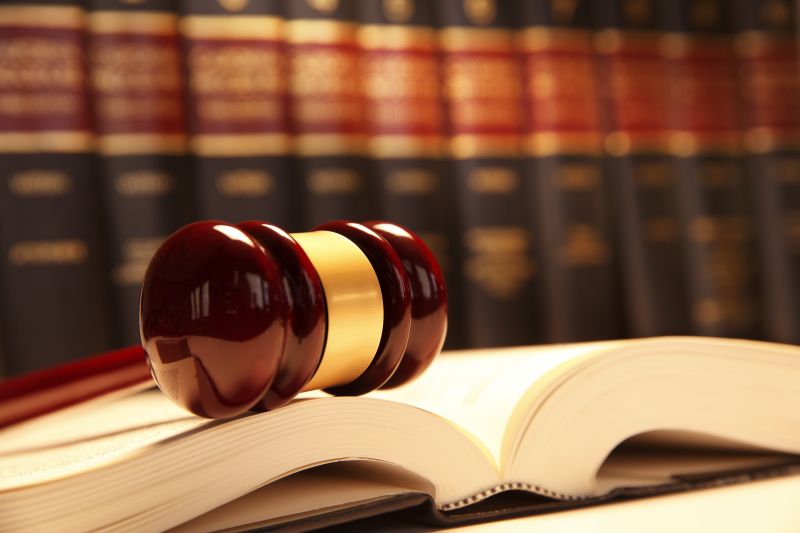
Writing in The Atlantic, Jacob Finkel, a former law clerk on the U.S. Court of Appeals for the Third Circuit, argues that “Trump’s Power Won’t Peak for Another 20 Years.”
The Trump presidency may be over, but the Trump era has only just begun—at least when it comes to influence over the nation’s courts. Measured solely by the number of judges he appointed, Donald Trump’s impact is staggering: 234 judges, including 54 powerful appellate judges, almost one out of every three. By comparison, President Barack Obama appointed 172 judges (30 of them appellate) in his first term, while George W. Bush managed 204 (35 appellate).
So, you’d think that this is the moment when Trump judges would be most powerful, no? After all, he will never appoint another one and President Joe Biden will soon start filling his own vacancies, likely soon to include a Supreme Court justice. But it’s about procedure and who controls it.
But Trump will have an even greater influence than this measurement suggests. That is because his judges won’t reach the apogee of their power until the early 2040s, when Trump-appointed chief judges are on track to simultaneously sit atop nearly every appeals court in the country.
This portends a potential disaster for progressive gains in many areas of law, including voting rights and health care. The limelight typically falls on the Supreme Court for these developments, but the lower courts are where much of the action happens. In its most recent term, which ended in July, the Supreme Court issued 63 signed opinions. The Circuit Courts of Appeals, by contrast, decided or issued orders on 48,300 cases in 2020. Although the Supreme Court has the final say, and Trump’s three new justices will shape the law for decades, the large majority of appeals—more than 97 percent—will be decided by the 12 geographic circuit courts, and the 167 appellate judges who sit on them. And the individuals who wield the most influence in shaping those outcomes are the chief judges of each circuit.
Officially, each chief judge has two roles: handling administrative matters and presiding over en banc (“full court”) hearings. Those are important, but they pale in comparison with the remarkable power the chief has behind the scenes—influencing which judges are assigned to which panels. A panel of three judges decides every appellate case, and the composition of those panels can be the whole ball game.
Imagine a nine-judge circuit court with a 5-4 liberal majority. A conservative chief could congregate three liberals in one panel and then erect two panels with a 2-1 conservative edge, swinging the effective conservative weight on that court from a 44 percent minority to a 67 percent advantage. I call this “judicial gerrymandering.”
The techniques that make this possible are already in use. Marin Levy and Adam Chilton, law professors at Duke University and the University of Chicago, respectively, have studied the partisan composition of panel assignments. Their findings “produce strong evidence that strictly random processes are not always used,” thus skewing “the ideological balance of panels.” In plain terms, this means that chief judges are permitted to quietly control which judges sit together, a power that could affect the rights of millions.
Chief Justices of the Supreme Court, going back to at least Warren Burger’s tenure, have been known to shrewdly switch sides in a case in order to control who writes the opinion. (The senior justice on the winning side has that prerogative.) But, since SCOTUS hears all its cases en banc, he can’t control who votes in individual cases. This is indeed a significant power, easily subject to abuse.
How this plays out today is generally pretty benign. On nearly every circuit, the assignment process begins with an automated system that randomly assigns judges to panels before allowing the chief to fiddle with those results. For now, chiefs generally take a minimalist approach to interventions: solving a scheduling conflict or separating panel members who loathe one another. Today’s chief judges would hesitate before aggressively stacking their courts with unequal panel assignments.
But much of what we know about the Trump nominees so far suggests that some may be willing to flout norms to achieve their ends. Many of Trump’s picks have “open experience in ideological and political warfare,” according to a report by The New York Times. A forthcoming study indicates that after 60 years of nonpartisan en banc decisions, the arrival of the Trump judges has fueled “a dramatic and strongly statistically significant” change in the en banc voting process, potentially turning it into “a weapon to advance majority party preferences.” Altering judicial assignments to attain certain results might not be beyond them.
This would be worrisome even if it were to affect only a handful of courts over time, but the reality is much more distressing. Because of a quirk that Trump’s nominations team seized, these judges will enjoy power for decades. When Congress introduced the chief-judge position in 1948, it created a seven-year post that would be filled by a circuit’s longest-serving judge under age 65. Trump’s team exploited that system in two steps. It began by picking nominees younger than Congress had ever imagined; this has been widely recognized, but did not itself maximize the number of future Trump chiefs. The crucial second step was nominating eligible judges in order of age.
Here’s how this is likely to shake out. Although Trump’s picks are unusually young, with an average age of 48, simply appointing three 48-year-olds to a single circuit would have done little good. In most circuits, that strategy would produce a single chief, during whose term the latter two would cross the age-eligibility line. In the optimal scenario, age is carefully aligned with seniority—start with a 48-year-old, followed by a 44-year-old, then a 38-year-old, which enables all three to serve as chief, producing an uninterrupted 20-year rule over their circuit.
That’s interesting, indeed. And it’ll take years to find out how it works out in practice.
Still, since all courts save the Supreme Court are creatures of Congress, they could presumably change how this all operates. They could impose rules on the creation of panels to preclude ideological cherry-picking. They could even change how chief judges are selected, requiring Senate confirmation.

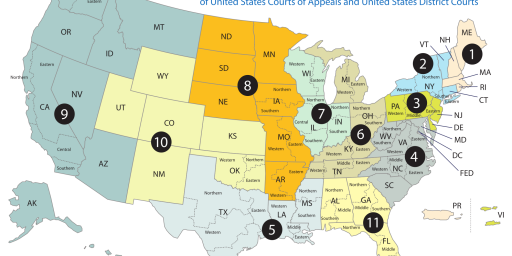
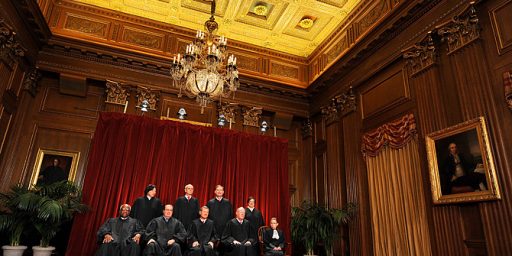
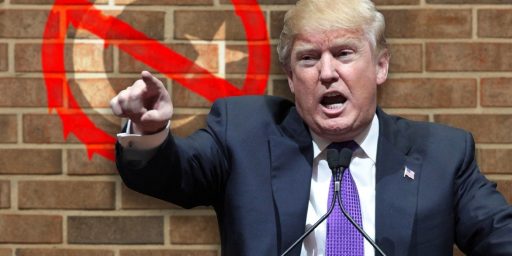
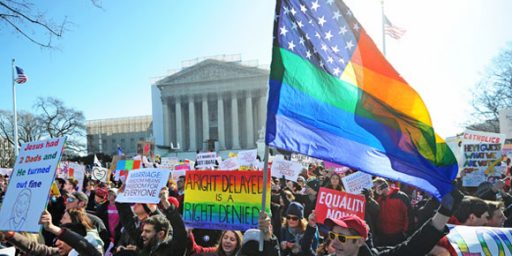

The biggest factor will be the amount of Judges in the lower courts who retire or opt for Senior status.
As for SCOTUS I expect that Biden’s first term won’t have many opportunities.
Three justices are 70 or above. Breyer is the oldest at 82. Thomas is 72. Alito is 71. After that we have Roberts and Sotomayor who are both 66. Kagan is 60. After that all the Justices are under 60 with Barrett the youngest at 49.
Breyer may choose to resign while there’s a Democrat in the White House and Democrats control the Senate but his departure would have a minimal impact on the Court’s balance. Alito and Thomas, meanwhile, are unlikely to step down absent serious health issues.
What this tells me is that Biden may only have one SCOTUS appointment in his first term and that could be hamstrung if the GOP wins back the Senate in 2022
So, we have here an excellent illustration of the deep problems in our institutions.
Trump loses the popular vote by millions and has this kind of long-term influence over national politics (as confirmed by a minority-representing Senate). And yes, I am being a broken record.
@Steven L. Taylor: Yeah but this is exactly what the Framers envisioned, dontchaknow. It’s a republic, not a democracy!
@Steven L. Taylor:
The problem, of course, is that changes that could address most of these problems that many people recognize cannot happen within supermajority support on Congress and among the states.
In this context that includes age or term limits for Judges and SCOTUS Justices as well as some of the other proposals. Congress could increase the size of SCOTUS or make changes to the lower courts but that will run up against the filibuster as well as resistance from some moderate Democrats.
@Steven L. Taylor, @James Joyner & @Doug Mataconis:
A consensus acknowledgement of the deep problems in our institutions, followed immediately by a recognition that there is absolutely nothing we as a nation can do about them, has me a little concerned that US claims of exceptionalism may be unwarranted.
@Scott F.:
It’s easier for a simple majority to make major changes in a Parliamentary system but I’m not sure that is a good thing
I may be missing something, but I found this story to be weak (to put it mildly). The language was particularly irksome, creating the appearance of certainty through innuendo and the like. Let’s walk through some examples (bold font is mine)…
This sounds scary upon first read, but a closer look renders it weak sauce. What the hell does “not always used” mean (what was used instead and why?) and how can one find “strong evidence” of it? Moreover, what is “strong evidence” in this context? Note also the descriptor “strictly” – this pings my something’s being hidden radar. Let’s continue…
Judges are permitted to do a lot of things that they don’t do. And when they do decide to do these, presumably naughty but allowed, things, there’s no good reason to think they will all choose to do the same naughty thing……except, of course, that they were appointed by Trump. Now this may sound like an indictment, because as we know, all Trump-appointed judges are the same naughty hacks. Until one remembers that Trump judges were among those who rejected his post-election cases. Hell, Trump-appointed SC justices haven’t consistently delivered the goods that Trump et al expected. Note also the “could” language in the last sentence. I may be particularly grumpy about language, but this kind of stuff drives me mad. Let’s continue…
Who is this “we” and what do “we know”? Note the continued weak sauce wording (“suggests”, “some”, “may be”). And pray tell what are “their ends”? Scary innuendo and little more.
How many is “many”? And what the hell does “open experience with ideological and political warfare” even mean? This strikes me as overly dramatic and intended to manipulate the reader. Let’s continue…
Wait a minute, how is it possible to do a study on this when these naughty manipulations were done “quietly” (see above). Nevertheless, the first sentence may well be true, but I thought the whole point of the story is to scare readers about what is to come when the Trump judges attain power. So how can it be that they initiated these changes in the process if they are so young and not yet in power? And the phrase “strongly statistically significant” – dramatic in fact – is an offense to anyone who’s taken more than an intro to stats course…..and many Bayesians have just added another name to their kill list. Note again the language (“potentially”). And the last bolded bit is so ridiculous as to not warrant further comment.
I say all of this not as a defense of Trump or his appointed judges. Nor do I intend to minimize the topic (changes to voting process). Rather, my point is to call attention to (and express my disdain for) writing like this, which is ubiquitous and harmful.
It should be noted that the issue is not that these judges are Trump appointees, or that they’re Republicans. They are, and that’s bad, but the real issue is that they’re Federalist Society. They are anti abortion, anti civil rights, anti voting, and pro gun, but that’s incidental. Charles Koch and his buddies didn’t spend millions selecting and training these guys to get rid of Roe v Wade. These judges are pro establishment, pro corporate, and, at the appellate and SCOTUS level, armed with “originalism’, which is a weapon designed to overturn long-standing precedent. Robert Bork almost single handedly screwed up antitrust law. What a bunch of these guys could do really is frightening.
Under current procedure the makeup of a three-judge appeals panel, the makeup of a panel is intended to be entirely random. The Clerk’s Office, made up entirely by non political appointees from the civil service ranks in the Judiciary, make that selection randomly, taking into account the caseload each of the judges has at that time. My understanding is that the Clerks now use a computer program to make the selection. The process in the District Courts is by and large the same. Although attorneys try its generally speaking difficult to Judge shop.
Substituting that for something where the Chief Judge has role in the process makes the process less random and more subject to potential abuse.
As for the Chief Judge position itself bringing the Senate into the process strikes me as unnecessary. The current system has worked fine for a long time. Also, inserting the Senate into this process would slow things down with no discernible benefit.
@Doug Mataconis: Finkel clerked for the 3rd Circuit, so he presumably knows the process. Is he fearmongering, concocting wild fantasies, or what?
Scott Lemieux at LGM notes the Supremes have ruled 5-4 that California cannot regulate the size of in-home religious gatherings. He quotes Kagan’s dissent, which seems to pretty well cover the situation. The majority have decided hurt religious fee fees are more important than public health. Lemieux titles the piece “The Court of Death”, which seems appropriate. Republicans claim to be the party of life and the party of personal responsibility. They lie.
@James Joyner:
What I’m describing is how things are supposed to work. If they aren’t working that way we need to fix that.
Another thing we need to consider is a realignment of the 9th Circuit, which has the highest caseload of any Cirruit at both the District and Court of Appeals levels due primarily to the fact that California is part of the Circuit. As I’ve written about before we should break apart the 9th circuit and create a 12th Circuit;
https://www.outsidethebeltway.com/republicans-looking-at-plans-to-break-up-the-ninth-circuit/
@gVOR08
“Congress shall make no law…..” is pretty explicit you know